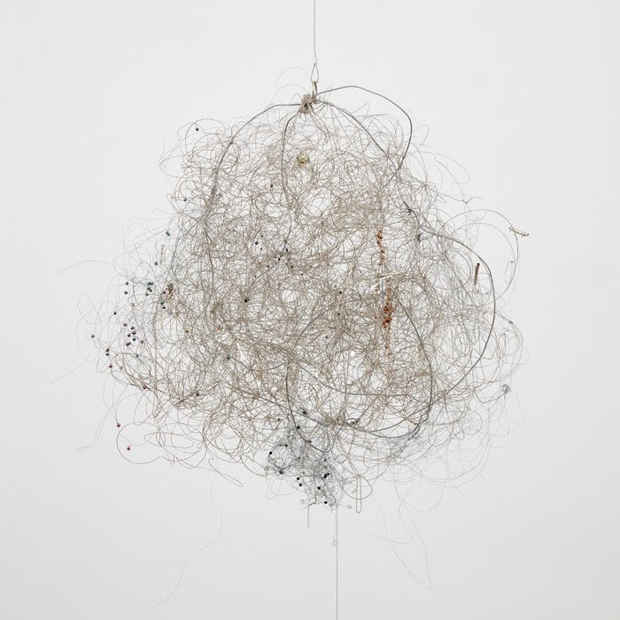“Adams, Beasley, Crowner, Dash” Exhibition
Casey Kaplan

[Image: Igshaan Adams "GETUIE (witness) vi" (2021) Metal, glass, and rubber beads, metal wire and chain, car paint, resin, 34 x 25 x 27 in. Photo: Jason Wyche.]
This event has ended.
To coincide with Igshaan Adams’ inaugural exhibition, Casey Kaplan is pleased to present a special group exhibition in Gallery II, featuring new artworks by Igshaan Adams, Kevin Beasley, Sarah Crowner, and N. Dash. The four artists use disparate methodologies to trace cultural memory, working with a wide variety of media, including textile, cotton, wire, beads, earth, fiber, acrylic, string, enamel, resin, clothing, and oil. Each material component is imbued with the residue of labor and production, along with stories of lived experience. Resisting medium specificity, each artwork functions as sites for these layered histories, encouraging the viewer to connect through their own narratives.
Installed in the center of the space is a large-scale installation by Adams composed of wire fencing and studio detritus hovering above a meandering floor weaving. This cloud-like object attempts to give form to the irregular contours of dust clouds generated during the indigenous, celebratory dance “Rieldans,” which is rooted in the traditions of the Khoisan, the original inhabitants of Southern Africa. The work moves ever so slightly, activated by the motion of air as visitors approach it. The woven floor tapestry underneath is constructed from locally sourced varieties of beads, seashells, nylon rope, and cotton thread. It serves as a record of memory and movement through the remnants of a domestic space, approximating the pathway inside the home of one of Adams’ childhood neighbors in Cape Town.
A new, elevated “slab” work by Kevin Beasley traverses an opposing wall. The work is comprised primarily of resin, raw cotton (harvested in Valentines, VA by a farmer who leases land from the artist’s family’s ancestral property), and a grid of t-shirts emblazoned with photographs Beasley took of flowering cotton fields (a 4-6 week period in which the plant blooms from white, yellow and pink to a deep red, prior to its ripening stage when the cotton boll begins to form). In a leap towards pictorial narrative through the merging of abstraction and the representation of a landscape, Beasley acknowledges the complex, shared histories of the broader American experience as it relates to the history of cotton production and black land ownership in the South.
On the adjacent wall, a monumental textile by Sarah Crowner pushes the boundaries of traditional painting through both formal and material play. The artwork incorporates patterns and shapes characteristic of Crowner’s distinct visual language, rendered in tightly woven fibers instead of her traditional cut and sewn canvas. Pigmented in bright violet hues, the tactile composition functions as a colorful foil to the more earthy tones that dominate the room. By engaging fields of botany, architecture, and modernism, Crowner reimagines ecological and art historical referents through the process of abstraction.
Nearby, two new works by N. Dash fuse sculptural elements with the language of painting. Informed by the erosion of the environment and its exchange with the industrialized world, the work responds to spatial architecture and visually indexes the labor of human touch in its materials. These paintings, made of earth, paint, and other assembled components, extend out from and include the wall. Each element of the work emits a textural resonance, stimulating bodily awareness and durational engagement beyond the visual field.
Media
Schedule
from May 01, 2021 to July 30, 2021